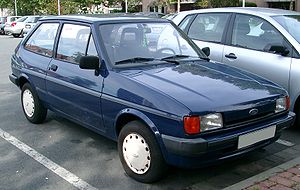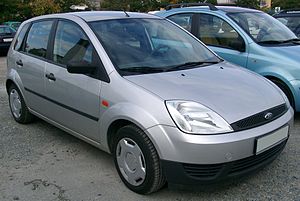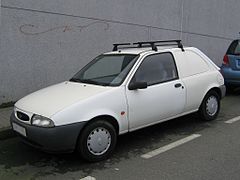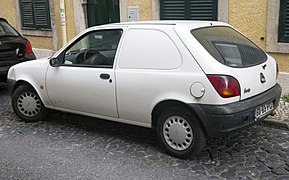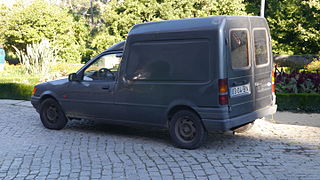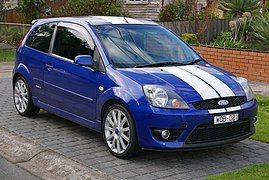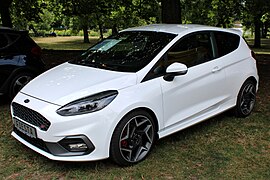Ford Fiesta
| Ford Fiesta | |
|---|---|
| Production period: | since 1976 |
| Class : | Small car |
| Body versions : | Station wagon , limousine , panel van |
The Ford Fiesta is a car model of the automobile manufacturer Ford that is sold worldwide . The small car has been built since May 1976, and more than 15 million vehicles have been produced worldwide to date. With around 9 million copies in the period 1979 to 2018, the majority of these vehicles were produced in Cologne . In the course of time the Fiesta has been technically improved and redesigned again and again, but not every modification measure is necessarily a new model.
The eighth model generation of the Fiesta has been available since July 8, 2017. Due to a different way of counting the revisions, one speaks in some cases, among others in Great Britain , of the seventh generation.
Fiesta '76 (1976-1983)
The Fiesta '76 was the first vehicle in the Ford Fiesta range. At the beginning of the 1970s, Ford began - like many European competitors - with the development of a small and economical vehicle. With the transversely installed engine and front-wheel drive, Ford deviated from the previous drive concept within the group. Except for two models, all Fords until then had front-engined and rear-wheel drive. The Fiesta was offered from May 1976 as a five-seater sedan or as a small delivery van. Valencia and Kent engines with a displacement of 1.0 to 1.6 liters, together with a fully synchronized four-speed gearbox, provided the drive.
In August 1981 a facelift was carried out in which numerous technical details were changed. The external distinguishing feature was the new, larger bumpers with plastic corners.
From 1977 to 1980 the Fiesta '76 was also offered on the US market. The US version, however, was also made in Europe.
Fiesta '84 (1983-1989)
The second series of the Fiesta is based on the floor pan of the predecessor, but is not considered a " facelift " because of the new abbreviations for the body shapes and the extensive changes to the front and the interior . In addition to the 1.0 and 1.1 liter engines of the predecessor with a side camshaft , the CVH engines introduced in 1980 with 1.3; 1.4 and 1.6 liter displacement to choose from. The new Fiesta was now also available with a five-speed gearbox. From the beginning of 1984 there was the first diesel engine in the Fiesta, from November 1986 an uncontrolled catalytic converter for the 1.1 liter engine, from March 1987 the first gasoline injection with G-Kat and from May 1987 a continuously variable CTX automatic transmission .
Fiesta '89 (1989-1996)
The 1989 model of the Ford Fiesta was a new development and now also available with five doors. In addition to a better chassis and significantly improved occupant protection, numerous extras such as electric windows, anti-lock braking systems , airbags, air conditioning, power steering and a heated windscreen were offered. The new Zetec 16V engine complemented the engine range, which continued to consist of the Valencia and CVH engines as in the predecessor. The new 1.8-liter diesel engine was also available with a turbocharger outside of Germany .
The facelift in January 1994 included detailed changes and technical and safety-relevant components.
The Fiesta '89 was offered as "Fiesta Classic" until August 1996, although production of the successor had already started in August 1995.
Fiesta '96 (1995-1999)
The floor pan of the Fiesta '96 was taken over almost unchanged from its predecessor, but the external appearance and also large parts of the technology differed significantly. The Kent engines remained in the program , the Zetec and CVH engines were replaced by the new Zetec SE engines. As with the Fiesta '89, the current Fiesta was offered as a courier with approval as a truck .
The third generation of the Mazda 121 was a Fiesta '96 built in the Ford factory in Cologne with some Mazda- specific modifications.
On the basis of the fourth Fiesta series, the small car Ford Ka was offered from autumn 1996 and the Ford Puma sports coupe from spring 1997 .
Fiesta '99 (1999-2001)
Although the Fiesta '99 is actually just an extensive facelift of the 1995 model, despite the same codes for the body shape (JAS / JBS etc.) it is usually regarded as the fifth series. The front section has been redesigned, the front and rear bumpers modified and the technology largely revised and improved. 14-inch wheels, internally ventilated disc brakes at the front, side airbags and a third brake light were standard equipment for all models. A turbodiesel was now available for all markets.
The third generation Mazda 121 received the same modifications.
Fiesta '02 (2001-2008)
The sixth generation of the Fiesta was based on a new platform and was significantly longer and wider compared to the previous models. Initially only available as a five-door version, the three-door version followed in June 2002. The old bumper engines were finally replaced by the more modern Zetec Rocam , the Zetec 16V engines and the Duratec HE with 2 liter displacement supplemented the range of gasoline engines. All diesel engines now had turbochargers and common rail injection . The vehicles were equipped as standard with belt tensioners , side impact protection , anti-lock braking system (ABS), electronic brake force distribution and four airbags; for an additional charge also with head-shoulder airbags. A manual five-speed gearbox or an automated version Durashift-EST was available.
In October 2005 there was a facelift with redesigned front and rear bumpers, different headlights, a high-quality interior and four new metallic paintwork. In addition, other extras such as an AUX input , Bluetooth and voice control functions, automatic light and windshield wipers, on-board computers , automatic air conditioning and folding exterior mirrors were offered.
In India the model was produced as Ford Figo from 2010. At the same time, the Fiesta '08 and, as the successor to the Ford Ikon, the Fiesta Classic were offered on the domestic market and other Asian countries from April 2011 . In spring 2010 this Fiesta was redesigned with new headlights and grille similar to the Fiesta '08 and offered under the names Fiesta One in Argentina, Fiesta Move in Venezuela and Fiesta Rocam in Brazil.
Fiesta '09 (2008-2017)
The new Ford Fiesta was presented at the Geneva Motor Show in March 2008. The vehicle is based on the floor pan of its predecessor, but is technically and optically a completely independent model. Electric power steering , anti-lock braking system, ESP with brake assist , four airbags, knee airbag for the driver, an adjustable steering wheel and central locking are standard in the basic model. After the Fiesta '76 , this is the second Fiesta to be sold in the United States , also as a notchback sedan.
The Zetec Rocam and Duratec engines were discontinued and the Zetec SE gasoline engines and two common rail diesel engines with turbochargers and particle filters were available for the market launch . The Ti-VCT camshaft adjustment was used for the first time in the Fiesta, in which both camshafts can be adjusted independently of each other.
In January 2013, an extensive optical and technical facelift was brought onto the market. The petrol engines have been supplemented by the new 1.0 liter three-cylinder engines, which are also available as EcoBoost with turbocharging and up to 103 kW (140 PS). A 1.6 liter Ecoboost engine was later also available, which in the Fiesta ST and ST200 developed up to 158 kW (215 hp).
For various markets in Asia, the Fiesta was also produced as a hatchback or notchback from 2011 in Chennai (India), where it replaced the Ford Ikon .
The last Fiesta of this series rolled off the assembly line on April 29, 2017.
Fiesta '18 (since 2017)
On November 29, 2016, the eighth generation of the Fiesta was officially presented at a Go Further event at the Cologne-Niehl plant . Production of the eighth model series started on May 16, 2017 in Cologne-Niehl; the official market launch took place on July 8, 2017.
Compared to its predecessor, the exterior of the new model has only been changed in a few details, the most striking here are the new taillights, which are no longer placed next to, but clearly below the rear window. The new Fiesta is seven centimeters longer and 1.2 cm wider. 15 different assistance systems are available for the model, including an emergency braking assistant , a parking assistant, a high beam assistant and an adaptive cruise control . Only three-cylinder petrol engines are available for the model launch , and the new Fiesta ST will also be delivered with a 1.5-liter three-cylinder EcoBoost engine from the beginning of 2018 . The diesel engines still have four cylinders.
commercial vehicles
Fiesta Van
The Fiesta Van , which was also marketed as a Fiesta small delivery van or Fiesta Express depending on the year of manufacture , is a small delivery vehicle . These vehicles are available directly from the factory and differ in only a few details from a conventional car of this series. So that the vehicles can also be registered as trucks , they only have two seats. The side parts of the vehicles are made in one piece without rear side windows. Depending on the year of construction, the tailgates are also without a window. Behind the front seats there is a - mostly flat - loading area with a floor area of over 1 m². These vehicles are only available with a very limited selection of factory extras and engines.
Since these vehicles do not have a significantly better utility for traders than conventional cars, they are only produced in very small numbers. They are mostly sold in countries where commercial vehicles are taxed less than passenger cars.
Fiesta Courier
The high-roof station wagon Fiesta Courier , which was also marketed as the Ford Courier , is, like the Fiesta Van, a truck based on the Fiesta. The front end was taken over unchanged, a modified and extended floor assembly provides more space in the cargo area, which is higher than in a car and is accessible via two doors at the rear of the vehicle. The coil springs on the rear axle were replaced by torsion bar springs in order to create the lowest possible loading area and as much space as possible and to be able to accommodate higher loads. In contrast to the Fiesta Van, the Courier offers significantly increased utility for business people and was therefore more widespread. The comfort equipment, optional equipment and the choice of engines were also very limited in the Courier and tailored to the needs of commercial customers. Depending on the model and configuration, the Courier was delivered with or without a rear bench seat, without rear side windows, with one small or one large window on each side of the cargo area.
The Courier was built on the basis of the third, fourth and fifth generation of the Fiesta. With the introduction of the Ford Fiesta '02 , the Courier was also discontinued and was replaced by the Ford Transit Connect , which is based on the floor pan of the first Ford Focus . In addition to the Courier, the Transit Connect also replaced the similar but larger Ford Escort Express.
Sporty models
Almost all model series of the Fiesta had a sports version, which - both in terms of engine power and appearance - clearly stood out from the rest of the models.
XR (1981 to 1996)
Unlike RS or ST , XR is not an abbreviation. The origin of this letter combination has not yet been clearly established. Various sources claim that this is a factory-internal code or a combination of letters that the developers of these vehicles would have liked particularly well. While the Fiesta was marketed as the XR2 , there were XR3 for the sportier models of the Escort and XR4 for the Sierra .
It began with the Fiesta XR2 of the first series . The 1.6-liter Kent engine had a 300 cm³ larger displacement than the next smaller engine in this series, it made 13 kW (18 hp) more. Externally, the XR2 differed from the other vehicles of this model with body extensions made of plastic, a small rear spoiler lip, round headlights, light alloy wheels, a lowered body and a sporty decoration ("rally stripes"). In the interior, a sports steering wheel, sports seats and a tachometer were part of the standard equipment. With a mechanical four-speed gearbox, the Fiesta with 62 kW (84 hp) accelerated to 100 km / h in 10.1 seconds. The mixture preparation of the OHV engine was carried out by a Weber register carburetor, the ignition system was contactless .
The Fiesta XR2 of the second series was presented around a year after the introduction of the new model. The new CVH engine still had a displacement of 1.6 liters, and the next smallest gasoline engine in this series had displacement of 1.4 liters. Although the same carburetor was used as in the predecessor, the performance of the XR2 could be increased to 71 kW (97 hp) thanks to the newer engine. Also new was ESC - mapped ignition with an external ignitor. The body extensions were significantly larger than on the predecessor, a rear spoiler, a lowered body and low-profile tires were again standard . Steel wheels with special hubcaps were offered ex works; the light alloy wheels of the predecessor were available as options. There is no elaborate decoration, there is only a small decorative strip on both sides of the vehicle. As with the predecessor, the sports steering wheel, sports seats and tachometer are standard, otherwise the equipment was based on the Ghia , the name for the best equipped vehicles at the time. From the second series onwards, the XR2 had a five-speed gearbox and accelerated to 100 km / h in under 10 seconds, the top speed was 180 km / h. After the facelift, a different cylinder head, a different carburetor and a different ignition system were used. The performance did not change, but there were different seat covers and door panels.
From the introduction of the third series , all XR2s had the suffix “i” , which indicates that these vehicles were now equipped with an injection system instead of the previously usual carburettor . The XR2i was already available with the introduction of the new model series, the CVH engine of the predecessor with 1.6 liter displacement now developed 76 kW (103 hp) with a regulated catalytic converter and a modern electronic injection system. In some countries the vehicle was also sold without a catalytic converter, the engine then developing 81 kW (110 hp). The plastic extensions were now painted in the same color as the car and four rectangular additional headlights were integrated into the front bumpers. As with its predecessors, the vehicle had sporty standard equipment such as a lowered body, wide tires, sports seats, a sports steering wheel and a rev counter. With the introduction of the new Zetec 16V engines, the model range was expanded in 1992 to include the XR2i 16V with 1.8 liter displacement and 96 kW (130 hp); the XR2i with the CVH engine was no longer produced in 1993. There were no major differences between the two XR2i - with the exception of the interior and the seats. The vehicles accelerated to 100 km / h in 10.1 and 8.5 seconds, respectively, and the top speed was 187 and 200 km / h, respectively.
After the last XR2i 16V were produced in 1994, the XR also disappeared from the type designation. Only the Escort was sold as the XR3i until the end of the 1990s. In Australia , Ford used the abbreviation XR until the end of production of the Ford Falcon in October 2016. The sporty models, which were usually called ST or RS in Europe, were named Fiesta XR4 , Focus XR5T , Mondeo XR5T as well as Falcon XR6 and Falcon XR8 .
RS (1991 to 1994)
RS is the abbreviation for R allye s port and has been used since the late 1960s for the sportiest road vehicles from Ford, which are then often used in motorsport, such as the Sierra RS Cosworth . The RS models of the Fiesta were not available ex works in German-speaking countries.
The Fiesta RS Turbo was introduced in 1991. The CVH engine with 1.6 liter displacement and 97 kW (132 hp) is similar to that of the Escort RS Turbo, the Fiesta has a slightly smaller Garrett T2 turbocharger and instead of the mechanical Bosch KE-Jetronic , an electronic injection system from Ford takes over the Mixture preparation. Externally, the RS Turbo differs only minimally from the Fiesta XR2i of this series. It was not sold in Germany due to the lack of a catalytic converter , as this was made mandatory for new vehicles shortly after the RS Turbo was introduced in Germany. Re- imported vehicles - mostly from Italy and the Benelux countries - could, however, be registered legally in Germany.
The Fiesta RS1800i was a limited special edition of the Fiesta in the United Kingdom . This Fiesta differed only in a few details from the XR2i 16V with 96 kW (130 PS), which was sold in unlimited numbers in Germany, among other things, and standard equipment there included Recaro seats and special light alloy wheels. Outwardly there was no difference between the British and the German XR2i 16V, but there the engine of the model sold here as Fiesta S with 77 kW (105 PS) was used for the 16V model.
Sport (1999 to 2002)
There was no sports model for the fourth series of the Fiesta. The Fiesta GT , with its somewhat sportier equipment , existed, but the 1.4-liter Zetec S engine with 66 kW (90 hp) was also available in other models such as the Ghia .
Only with the introduction of the fifth series there was a sports model of the Fiesta again. In this series, the Fiesta Sport exclusively had a 1.6-liter Zetec S engine with 76 kW (103 hp). After the performance of the most powerful Fiesta increased from generation to generation, the engine performance of the Sport remained far behind that of the Fiesta XR2i 16V or the RS Turbo. The performance was roughly on par with the Fiesta XR2i with the CVH engine. The sport differed from the other vehicles in the series with modified front and rear bumpers, a rear spoiler, sport seats, a lowered body and multi-spoke wheels with a diameter of 15 inches. In other countries these vehicles were also marketed as Zetec S.
ST (since 2004)
The abbreviation ST stands for S port T echnology and features since the introduction of the Mondeo ST200 end of 1999 in addition to RS the sports models of the Ford brand.
The first Fiesta ST was sold from the beginning of 2005 in the sixth series of the Fiesta and is still the series fiesta with the largest displacement. The exterior of the vehicle with sportier front and rear bumpers, side skirts, rear spoiler lip and large air intakes at the front of the vehicle was adopted from the vehicles of the Fiesta ST Cup . With a 1.6 liter Zetec-S, these racing vehicles developed 118 kW (160 hp), while Mazda’s 2.0 liter Duratec was used for series production . This engine was also used at Ford for a long time in other vehicles such as the Focus , C-Max , Mondeo, S-Max and Galaxy and developed 107 kW (145 PS). For the Fiesta ST, the output has been increased minimally to 110 kW (150 PS), which is why these vehicles are also called Fiesta ST150 , based on the Focus ST170 and the Mondeo ST200 and ST220 . The Fiesta ST was already extensively equipped factory, were added sporting partial leather seats, a leather steering wheel with ST logo, low-profile tires on 6,5x16-inch alloy wheels, specially tuned shock absorbers, a specially tuned torsion beam axle rear, a stronger stabilizer at the front and a five-speed -Sport transmission with shortened shift travel. In contrast to the previous sports models, the Fiesta ST was not lowered from the factory. The Fiesta ST was the first vehicle in this series with standard disc brakes on the rear axle. The exterior of the ST was not changed during the facelift at the end of 2005, only the changed headlights, taillights and the redesigned dashboard were also adopted for the ST. From this time on, ESP was also part of the standard equipment in Germany .
The Fiesta ST of the seventh series was sold from the beginning of 2013. In contrast to its predecessor, this vehicle has a 1.6-liter EcoBoost engine with four cylinders, which is equipped with gasoline direct injection , double, independent Ti-VCT camshaft adjustment and turbocharger and has an output of 134 kW (182 hp). This ST also stands out from the rest of the model's vehicles with modified bumpers, large light alloy wheels, roof spoiler, side skirts, lowered body and two tailpipes . In the interior, sports seats from Recaro are part of the standard equipment. Acceleration from standstill to 100 km / h takes 6.9 seconds, which is considerably faster than all previous Fiesta sports models, and the top speed of 223 km / h is mainly due to the now available manual six-speed sports transmission. From mid-2016, the Fiesta ST200 , limited to 500 units in Germany, was also offered, in which the performance of the vehicle was included in the model name for the first time. The engine of the Fiesta ST has been increased in performance, the ST200 offers 147 kW (200 PS), which can be increased to 158 kW (215 PS) for 20 seconds using an overboost function . The ST200 was only available with a gray exterior finish.
The Fiesta ST was available for the eighth series shortly after production began. The first vehicles were delivered from summer 2018, just under a year after the model change. The engine is now a three-cylinder EcoBoost with cylinder deactivation and an output of 147 kW (200 hp). In addition to direct injection , an additional intake manifold injection is used to make even better use of the engine's potential. As with its predecessors, the ST has a slightly different design on the outside, especially the bumpers, and on the inside from the other vehicles in the series. New in the standard or optional equipment are a mechanical limited slip differential , a launch control , a gearshift indicator and a flap control , which is supposed to have a positive effect on the engine noise. These parts are used in the new ST for the first time in the Fiesta. Another new feature is that this model can now also be ordered as a 5-door variant. So far, all of the Fiesta sports models have only been available as 3-door small cars.
Motorsport
Ford Fiesta Ladies Cup
From 1982 to 1986 the Ford motorsport department under Lothar Pinske organized a one-make cup , the first German racing series only for women.
The aim was to make it easier for talented female racing drivers to enter professional motorsport. The races took place in the framework of the German Racing Championship (DRM) and the European Touring Car Championship . The 20 drivers had to be between 18 and 29 years old, single and have a class 3 driver's license .
The cars were driven with a uniform Ford Fiesta XR2 of the first generation , which was equipped with a roll cage , fire extinguisher and harness belts. To ensure equal opportunities, the vehicles were allocated to a driver by drawing lots before each race. The cars were converted and looked after by Ford's motorsport department, the engine developed around 66 kW (90 hp), and the top speed of the vehicles was around 180 km / h. Ford provided the vehicles as well as the cost of the necessary equipment, including hotel, travel, food and prize money. The overall winner of a total of six races was allowed to keep her competition vehicle. For places 2 to 10 in the overall ranking, cash prizes of 5000 to 500 DM were planned.
From 1984 the field of participants was increased to 26 drivers, but the participants had to pay the costs themselves or with the help of sponsors.
Almost 1,400 women applied to Ford to take part in the racing series, 120 of them were invited to a three-day viewing course at the start-and-finish loop of the Nürburgring .
After the introduction of the second Fiesta generation and the presentation of the new XR2, these vehicles were used for the Ladies Cup from the 1984 season. With a manifold and a modified exhaust system, the CVH engine developed around 73 kW (100 hp).
master
| season | driver |
|---|---|
| 1982 |
|
| 1983 |
|
| 1984 |
|
| 1985 |
|
| 1986 |
|
In 1986, Ford organized the German Race of Champions with the vehicles of the Ladies Cup at Diepholz Air Base , where female racing and rally drivers from all over the world competed against each other based on the American model . The winner was the British rally driver Louise Aitken-Walker .
Ford Fiesta Mixed Cup
From 1990 to 1992, Ford organized a one-make cup with the Ford Fiesta XR2i as part of the DTM supporting program , in which a female / male mixed team competed per vehicle. Both pilots together could not be older than 55 years, because Ford wanted to "prefer the youngsters and not have old hands or even stranded semi-professionals in their cars". The purchase price for the vehicle was consciously in the lowest feasible range at 26,500 DM, the registrations had to be made through the Ford RS dealers. Ford provided more than DM 500,000 in prize money per season, and the winners of the annual ranking also received a new Ford Escort convertible.
The staging of the individual races was different - either there were two separate races, the times of which were added, or a run with a pit stop in the middle of the race including a driver change. Sometimes the male drivers started first, sometimes the women, and sometimes the field started mixed. The criteria for the composition of the starting groups differed from race to race and were kept secret by the organizer. As a recognition aid for the spectators, the vehicles in which the female half of the mixed team drove had to be marked with a yellow tennis ball on the roof. The starting field consisted of up to 50 cars, making the Ford Fiesta Mixed Cup one of the best-filled racing series.
master
| season | driver |
|---|---|
| 1990 |
|
| 1991 |
|
| 1992 |
|
Ford Fiesta ST Cup
From 2003 to 2007, the Ford Fiesta ST Cup as part of the Beru TOP 10 was the third one-make cup with the Fiesta. This sparked after the end of production of the Ford Puma the Ford Puma Cup from. The racing car based on the sixth series of the Ford Fiesta was equipped with a 1.6-liter Zetec SE with 125 kW (170 hp), but the series vehicle presented later as the Fiesta ST received the 2.0-liter Duratec HE with 110 kW (150 PS).
master
| season | driver |
|---|---|
| 2003 |
|
| 2004 |
|
| 2005 |
|
| 2006 |
|
| 2007 |
|
rally
For the participation in rallies , the Ford motorsport department prepared several Fiesta. The output of the 1.6 liter Kent engine was increased to 160 hp. Drivers were u. a. the German Michael Werner , Ari Vatanen and the Spaniard Salvador Servià . The greatest successes for the vehicle were tenth overall and second place in the class at the Monte Carlo Rally by Vatanen, Servià was ninth overall in 1980 and class winner in 1982. Servià won a run in the Spanish rally championship between 1979 and 1982 and achieved seven class wins, Werner also achieved a class win in the 1980 Cologne-Ahrweiler rally .
Ford Fiesta RS WRC
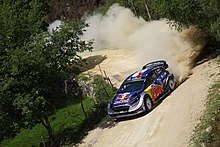
From 2011 Ford competed in the WRC with the Ford Fiesta RS WRC . The vehicle had a 1.6-liter turbo engine with a six-speed sequential gearbox and four-wheel drive. It replaced the Ford Focus RS WRC that had been used up until then and achieved a triple victory for drivers Mikko Hirvonen , Mads Østberg and Jari-Matti Latvala on its WRC debut at the 2011 Rally Sweden . Hirvonen finished second overall in the drivers 'standings, just eight points behind Sébastien Loeb , while the Ford works team and the private M-Sport team finished second and third in the manufacturers' standings .
The Ford works team also started in the 2012 season , and several private drivers and customer teams continued to use the Fiesta. At the end of the season, Ford ended its involvement in the World Rally Championship. Since then, the M-Sport team has continued to compete with the Fiesta as a private team.
For the 2017 World Rally Championship , M-Sport developed a new rally vehicle based on the new model . The Frenchman Sébastien Ogier , who won the World Championship four times in a row for Volkswagen from 2013 to 2016 , won the drivers' championship in the World Rally Championship straight away in the new Fiesta. After Björn Waldegård and Ari Vatanen, Ogier is only the third driver to win the world championship in a Ford. Waldegård was world champion in 1979 on an Escort RS1800, Vatanen in 1981 on a privately used Escort RS1800. M-Sport also won the manufacturers 'championship for Ford in 2017 - for the first time with a Fiesta. Ogier also won the 2018 World Rally Championship in the Fiesta, and Ford took third place in the manufacturers' championship.
Rallycross
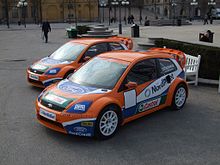
Based on the sixth and later the seventh series, Olsbergs built a vehicle for the European Rallycross Championship in Sweden . The car with a body made of Kevlar has little in common with the series Fiesta apart from the external appearance. The Fiesta is converted to all-wheel drive, the longitudinally mounted 2.0-liter Duratec -Motor makes a Garrett - turbocharged 404 kW (550 hp) and develops a torque of 820 Nm. The 1200 kg vehicle accelerates from standstill to 100 km / h in 2.8 seconds. The brake discs manufactured by Alcon have a diameter of 365 millimeters on the front and 315 millimeters on the rear axle.
A seventh-generation Fiesta with an output of around 600 kW was prepared for the Pikes Peak International Hill Climb 2009; the driver was Marcus Grönholm from Finland . Due to technical problems, however, Grönholm was unable to beat the fastest time.
literature
- Ford-Werke Cologne: Ford moves - 75 years of Ford in Germany . Delius Klasing Verlag, Bielefeld 2000, ISBN 3-7688-1239-1 .
- Rainer Braun, Ferdi Kräling: Snapshots - A journey through time through 75 years of Ford Motorsport in Germany . HEEL Verlag, Königswinter 2000, ISBN 3-89365-904-8 .
- Stefan Rossbach: Ford: passenger cars since 1945 (type compass) . Motorbuch-Verlag, 2007, ISBN 978-3-613-02692-6 .
- High Performance Fiestas 1979-1991 . Brooklands Books, Surrey (UK) 1991, ISBN 1-85520-127-5 (English).
Web links
- Official website of the Ford Fiesta
- Official website of the Ford Fiesta Van ( Memento of July 5, 2013 in the Internet Archive )
- Link catalog on the topic of Ford Fiesta at curlie.org (formerly DMOZ )
Individual evidence
- ↑ Chronology 35 years of the Ford Fiesta. (PDF; 702 kB) (No longer available online.) Media.ford.com, July 29, 2011, archived from the original on January 6, 2012 ; accessed on March 26, 2014 . Info: The archive link was inserted automatically and has not yet been checked. Please check the original and archive link according to the instructions and then remove this notice.
- ↑ Strong car location Cologne by Corinna Schulz in the Kölner Stadt-Anzeiger , January 24, 2020
- ↑ Fiesta Timeline. (PDF; 4.6 MB) (No longer available online.) Ford Motor Company, archived from the original on March 8, 2014 ; accessed on December 28, 2012 (English). Info: The archive link was inserted automatically and has not yet been checked. Please check the original and archive link according to the instructions and then remove this notice.
- ↑ http://documentslide.com/download/link/still-going-strong-fords-youthful-spirited-fiesta-is- ( page no longer available , search in web archives ) Info: The link was automatically marked as defective. Please check the link according to the instructions and then remove this notice.
- ↑ http://www.ford-fiesta.de/allgemein/geschichte.html
- ↑ a b c d Rainer Braun, Ferdi Kräling: Snapshots - A journey through time through 75 years of Ford Motorsport in Germany . Ed .: Ford-Werke AG, Cologne, Ford Racing. HEEL Verlag, Königswinter 2000, ISBN 3-89365-904-8 , p. 166 ff .
- ↑ Ford press release: 25 years of the Ford Fiesta. (No longer available online.) July 2001, formerly in the original ; accessed on March 31, 2012 . ( Page no longer available , search in web archives ) Info: The link was automatically marked as defective. Please check the link according to the instructions and then remove this notice.
- ↑ Claudia Ostlender-Weiss: The Power Lady. (PDF) (No longer available online.) 2001, formerly in the original ; accessed on March 31, 2012 . ( Page no longer available , search in web archives ) Info: The link was automatically marked as defective. Please check the link according to the instructions and then remove this notice.
- ^ German Ford Fiesta Ladies Cup 1985. Motorsport-Archive.com, accessed on March 31, 2012 (English).
- ↑ Presseportal.de: Ford Fiesta ST Cup: Popular sport at a high technical level. April 30, 2003, accessed March 31, 2012 .
- ^ A b c Rainer Braun, Ferdi Kräling: Snapshots - A journey through time through 75 years of Ford Motorsport in Germany . Ed .: Ford-Werke AG, Cologne, Ford Racing. HEEL Verlag, Königswinter 2000, ISBN 3-89365-904-8 , p. 176 ff .
- ↑ Ford Fiesta ST: Big appearance at the European X Games premiere from May 16-19 in Barcelona. (No longer available online.) Media.ford.com, May 15, 2013, formerly in the original ; Retrieved June 16, 2013 . ( Page no longer available , search in web archives ) Info: The link was automatically marked as defective. Please check the link according to the instructions and then remove this notice.

